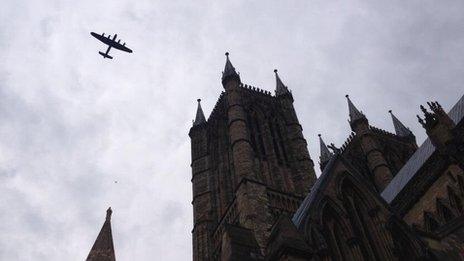Dambusters: Flypast and service mark 70th anniversary
- Published

Hundreds of people gathered around Lincoln Cathedral to watch the flypast
A flypast has taken place over Lincoln Cathedral to mark the 70th anniversary of the World War II Dambuster raids.
A Lancaster bomber from the RAF Battle of Britain Memorial Flight and a pair of Tornado aircraft from 617 Squadron took part.
Earlier, 1,300 people attended a service to pay tribute to the crew of the 19 Lancaster bombers, which took off from RAF Scampton on 17 May 1943.
More than a third of the men did not return from the raids.
Only three of the original 133-strong squadron are still alive.
Two of them, 94-year-old John "Les" Munro and 91-year-old George "Johnny" Johnson, attended the service along with Mary Stopes Roe, the daughter of "bouncing bomb" inventor Barnes Wallis.
Councillor Nick Worth, who helped organise the event, said: "Since the earliest days of the RAF, Lincolnshire has been an important part of its story and these close ties continue to this day.
"The county played a major part in the war and there were thousands of airmen who left Lincolnshire on bombing missions never to return.
"Therefore, it's only fitting we mark their sacrifice in this way."
RAF Chaplain-in-Chief Raymond Pentland said at the ceremony that Lincoln Cathedral had been "significant for generation after generation - but perhaps never for so many as those who served with Bomber Command in this county".
"For it was a sign of coming home."
'Loss of life'
He added: "Seventy years ago 617 Squadron was formed with a very specific mission in mind.
"And about this time 70 years ago, the aftermath of that operation was being evaluated - the cost was being counted - in loss of life on both sides.
"But, from the brilliance of Barnes Wallis and the daring leadership of Guy Gibson. and the skill of his crews. we have a story of bravery, ingenuity, tenacity and the will to overcome all adversity."
Compared to today's pilots, who must fly 250ft (76m) above ground, they flew incredibly low at 60ft (18m). They also had to fly at night.
They flew so low, according to historian Dan Snow, that one hit the sea, tearing off the bomb carried by the plane. Another flew into high voltage electricity cables and was engulfed in flames.
More than 1,300 people were killed in the raids, in which bombs were dropped on German dams flooding the Ruhr valley.
- Published17 May 2013
- Published16 May 2013
- Published16 May 2013
- Published16 May 2013
- Published16 May 2013
- Published21 March 2013